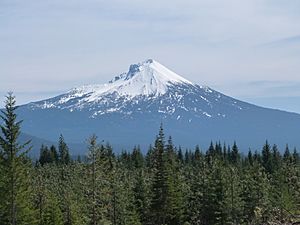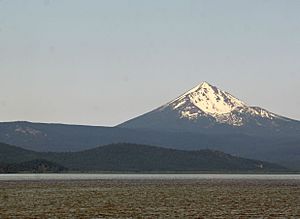Mount McLoughlin facts for kids
Quick facts for kids Mount McLoughlin |
|
|---|---|
| Alwilamchaldis, Mayakax, Kesh yainatat | |
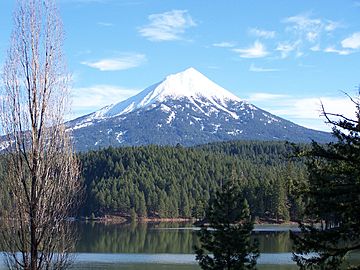
Mount McLoughlin from across Willow Lake
|
|
| Highest point | |
| Elevation | 9,493 ft (2,893 m) NAVD 88 |
| Listing | Oregon county high points |
| Geography | |
| Location | Jackson County, Oregon, U.S. |
| Parent range | Cascade Range |
| Topo map | USGS Mount McLoughlin |
| Geology | |
| Age of rock | Less than 700,000 years |
| Mountain type | Stratovolcano |
| Volcanic arc | Cascade Volcanic Arc |
| Last eruption | About 30,000 years ago |
| Climbing | |
| Easiest route | Trail hike |
Mount McLoughlin is a tall, cone-shaped stratovolcano in southern Oregon. It is part of the Cascade Range and sits within the Sky Lakes Wilderness. This mountain is a key part of the Cascade Volcanic Arc, a chain of volcanoes.
Mount McLoughlin is a well-known landmark for the Rogue River Valley. It is located north of Mount Shasta and northeast of Crater Lake. The mountain was named around 1838 after John McLoughlin, an important leader of the Hudson's Bay Company. For thousands of years, Native American groups have seen Mount McLoughlin as a special landmark.
The volcano is mostly made of a rock called basaltic andesite. It had three main periods of eruptions. Its last activity happened between 30,000 and 20,000 years ago. Today, no one is actively watching the volcano for new activity. The area around Mount McLoughlin is home to many different plants and animals. It gets a lot of snow and has big temperature changes between seasons. The Pacific Crest Trail goes along the east and north sides of the mountain. This trail also leads to the only path to the top, which is the 6-mile (9.7 km) McLoughlin Trail 3716. You can also ski on the mountain.
Contents
Exploring Mount McLoughlin
Mount McLoughlin is a major landmark for the Rogue River Valley. It stands tall at 9,493 feet (2,893 m). It is the tallest volcano between Mount Shasta (70 miles or 110 km south) and South Sister (120 miles or 190 km north). The mountain is located in the Cascade Range in southern Oregon. Most of it is in Jackson County, but its eastern base is in Klamath County. It is the sixth tallest peak in Oregon.
The volcano has two smaller peaks on its sides called North Squaw Tip and South Squaw Tip. These are at elevations of 7,070 feet (2,150 m) and 7,654 feet (2,333 m). You can see Mount McLoughlin from Interstate 5 and U.S. Route 97. From the southwest and southeast, the mountain looks perfectly shaped. However, the northeastern side has been worn away and now looks like a hollow bowl.
Sky Lakes Wilderness Area
Mount McLoughlin is inside the Sky Lakes Wilderness area. This area is part of the Rogue River–Siskiyou National Forest and the Fremont–Winema National Forest. The Sky Lakes Wilderness covers 113,590 acres (45,970 ha). It is about 6 miles (9.7 km) wide and 27 miles (43 km) long. The United States Congress created this wilderness area in 1984.
It stretches from Crater Lake National Park south to Highway 140. The elevation ranges from 3,800 feet (1,200 m) in the Middle Fork canyon of the Rogue River to the top of Mount McLoughlin. The wilderness area has more than 200 lakes and ponds. It also features many forests and mountain ridges.
Weather and Water Around the Mountain
The local area has warm, dry summers with cool nights. Winters are snowy, which makes it hard to get into the Sky Lakes Wilderness until July. There is not much rain between June and October, except for some thunderstorms. This means plants have a very short time to grow between when the ice melts and when it gets too dry. On average, lower elevations get about 40 inches (100 cm) of rain and snow. Higher up, it can get 80 to 90 inches (200 to 230 cm), mostly as snow.
Around the base of the mountain, there are several lakes. These include the Lake of the Woods and Fourmile Lake. The Upper Klamath Lake, which is the largest freshwater lake in Oregon, is to the east of Mount McLoughlin. Summit Lake is a small lake on the north side of the volcano. The Big Butte Creek, which flows into the Rogue River, drains the northwestern part of McLoughlin. The Little Butte Creek gets water from the southern sides of the mountain.
Plants and Animals
About 20 types of trees grow around Mount McLoughlin. At lower elevations, you can find Pacific yew trees. Higher up, there are mountain hemlock, whitebark pine, and subalpine fir. Lodgepole pine and red fir trees grow all over the area. Other plants include shrubs, wildflowers, junipers, heather, columbine, kinnikinnick, huckleberry, chinquapins, grouse huckleberry, and bearberry.
Common animals in the area include chipmunks, deer, elks, American black bears, and coyotes. Less common animals are yellow-bellied marmots, fishers, pikas, and American martens. More than 150 kinds of birds live in the Big Butte Creek area near McLoughlin. You might see eagles and hawks, as well as spotted owls. Goshawks like to live under the trees.
Amphibians like Oregon spotted frogs and Cascades frogs live in some parts of the watershed. Fish species include Chinook salmon, rainbow trout, Coho salmon, Pacific lamprey, and coastal cutthroat trout.
How Mount McLoughlin Formed
Scientists didn't know much about Mount McLoughlin's geology until the 1970s. Most of what we know now comes from LeRoy Maynard and James Smith. Their work helped us understand how the volcano was built.
McLoughlin is part of the High Cascades mountains, which run north to south. These mountains formed towards the end of the Pleistocene Epoch. They sit on top of older volcanoes that sank because of cracks in the Earth's crust. Like other Cascade volcanoes, Mount McLoughlin was fed by hot, melted rock called magma. This magma formed when the Juan de Fuca tectonic plate slid under the western edge of the North American tectonic plate.
The volcano has magnetic high points to its east. This suggests it is less than 700,000 years old. Other signs that the volcano is young include its even shape on the west and south sides. Also, its lava flows look fresh, and there isn't much soil on them.
McLoughlin is a stratovolcano. This means it's a tall, cone-shaped volcano made of many layers of hardened lava and ash. It is built on top of older, flatter volcanoes called shield volcanoes. Most of its main cone formed in the last 200,000 years. Lava flows on its sides are between 30,000 and 20,000 years old. The volcano's lava is mostly basaltic andesite.
During the last ice age, a huge sheet of ice covered most of the High Cascades. This ice was thousands of feet thick. Pleistocene glaciers carved out parts of McLoughlin's main cone. They dug out two hardened lava tubes that reached the top crater. From 25,000 to 12,000 years ago, glaciers on the north side of the volcano joined with an ice cap at its base. This ice cap was about 500 feet (150 m) thick. A cirque glacier, which is a bowl-shaped hollow carved by ice, stayed in part of the mountain until the early 1900s. The volcano usually doesn't have much snow during the summer.
Nearby Volcanoes
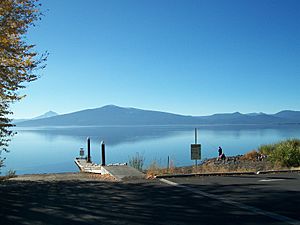
Two nearby volcanoes look a lot like Mount McLoughlin. Brown Mountain is a shield volcano to the southeast. Pelican Butte is the most important shield volcano in the southern Cascades of Oregon, and it is to the east.
Brown Mountain is between 60,000 and 12,000 years old. It produced lava flows that haven't been worn away much. But during the ice age, ice streams on the volcano carved out the cinder cone at its top. This created a bowl-shaped hollow on its northeastern side.
Pelican Butte reaches 8,036 feet (2,449 m) high and has gentle slopes. It is next to Klamath Lake. Pelican Butte is larger than McLoughlin. It is also made of basaltic andesite. Like Brown Mountain, Pelican Butte has a cinder cone at its top. It also has a hollow and a valley carved by glaciers on its northeastern side. These areas show rocks made from explosive eruptions mixed with lava flows. This suggests that blocky and ʻaʻā lavas formed an outer layer around Pelican Butte's broken inside. Glaciers have also made the volcano tens of yards shorter.
Other volcanoes are found in the Sky Lakes Wilderness area. These include lava flows and mud flows at Big Bunchgrass Butte and Imagination Peak. There was also more recent activity at Goosenest Mountain in the northeast.
Mount McLoughlin's Eruptive History
Mount McLoughlin had at least three different periods of eruptions. Early eruptions were very explosive. They produced ash and volcanic rock that built about a third of the volcano's total size. These eruptions also created lava flows, but only on the lower sides of the mountain.
The northwestern side has volcanic vents that produced lava flows. These flows covered the Fourbit Creek valley, 4 miles (6.4 km) from McLoughlin's base. They even reached the Big Butte Springs. Other lava flows from earlier eruptions reached at least 6 miles (9.7 km) from the mountain's base. Many of these flows run along the Oregon Route 140 highway. One ʻaʻā lava stream filled a river valley for 6 miles (9.7 km). It moved from an elevation of 5,000 feet (1,500 m) down to 3,000 feet (910 m).
A second period of eruptions involved large lava flows. These flows covered the inner core of ash and rock with basaltic andesite. These thin lava flows formed a shell around the loose inner part of the volcano. The third period involved floods of blocky lava erupting from below the summit. More liquid lavas also erupted from cracks at the base, mostly on the south slope. North Squaw Tip and South Squaw Tip on McLoughlin's west side are where two major blocky lava flows came out. There are also two smaller vents.
Scientists think this third stage happened after the last glaciers in the area melted. This is because the hardened lava looks fresh and hasn't been worn down much. The newest lava flows on Mount McLoughlin are on its southern and western sides. They are thought to be between 30,000 and 20,000 years old.
Will Mount McLoughlin Erupt Again?
Mount McLoughlin's main cone has not erupted in the last 11,700 years. The last lava flows were between 30,000 and 20,000 years ago. The volcano is not currently being watched for new activity. The closest stations that monitor earthquakes are 100 km (62 mi) south, near Mount Shasta and the Medicine Lake Volcano.
Human History of Mount McLoughlin
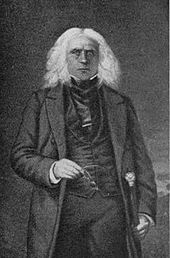
Mount McLoughlin has been an important landmark for Native American groups for thousands of years. They used the area for hunting and gathering berries. The Takelma people called it "Mal-sr" or "Alwilamchaldis," after one of their mythical heroes. They believed it was the home of Tasuune, the "Acorn Woman," who helped their acorns grow each year.
The Shasta people knew McLoughlin as "Makayax." The Klamath people called the volcano "Walum" and "Kesh yainatat," meaning the home of the "dwarf old woman" who controlled the west wind. The Modoc people called McLoughlin "Melaiksi." The Little Butte Creek, which flows from McLoughlin, was called "So-ytanak" by the Upper Takelma people. This means "corner" or "rock house."
An American explorer named Peter Skene Ogden first saw McLoughlin in 1827. He called it "Mt. Sastise" after the Shasta Native Americans. But this name was later used for Mount Shasta in northern California. Local people called Mount McLoughlin "Mount Pitt." It was also known by other names like Mt. John Quincy Adams, Mt. Clear View, Snowy Butte, and Mt. Madison. Maps showed it as Mount Pitt, Mount Simpson, and Mount Jackson.
Even though it was also called Mount McLoughlin in the 1800s, the Oregon Legislative Assembly officially renamed it in 1905. They named it after Dr. John McLoughlin, who was known for helping American settlers in the 1830s and 1840s. McLoughlin was an important person in the fur trade and was called the "Father of Oregon." The United States Board on Geographic Names confirmed the name change from Pitt to McLoughlin in 1912.
Fur trappers and explorers visited the area around Mount McLoughlin often. But they didn't stay for long. Settlers near the Sky Lakes Wilderness trapped beavers and martens in winter. They also hunted and grazed sheep in warmer months. Stuart Falls and Twin Ponds were popular places to pick huckleberries.
Trails and fire lookouts were built in the Sky Lakes Wilderness in the early 1900s. The Pacific Crest Trail was extended into the region in the mid-1970s. It took the place of the older Oregon Skyline Trail.
The first known climb to the top of Mount McLoughlin happened in 1858. Joseph Burpee, William Wilkinson, Dr. Greer, Henry Klippel, John S. Love, and Robert Haines from Jacksonville reached the summit from the northeast. This event was reported in a letter in the Jacksonville Democratic Times newspaper in 1897. In 1896, members of the Mazama mountaineering club, including Lottie Reed, Henry Pittock, and Leslie Scott, also climbed the mountain.
Since 1926, the western side of Mount McLoughlin has been a water source for Medford. The melted snow feeds the Big Butte Springs near the city. In summer, the melting snow forms a shape that locals call "the angel wings" or "the diving eagle." Local fishers see this as a sign that it's a great time to fish in the mountain's lakes.
Fun Activities on Mount McLoughlin
Mount McLoughlin has a 5-mile (8.0 km) hiking trail to its summit. It's not a super technical climb, but the trail goes up about 4,000 feet (1,200 m). It usually takes at least six hours to go up and down. Many people use this trail each year. The best time to reach the peak is from July to September. During these months, you can drive to the trailhead, and there's not much snow on the path.
The Mt. McLoughlin Trailhead is on Forest Road 3650, 2.5 miles (4.0 km) north of Oregon SR-140. After about 1 mile (1.6 km), the Mt. McLoughlin Trail joins the Pacific Crest Trail for half a mile. Then it goes through a forest for about 2.5 miles (4.0 km) before reaching the timberline. The last mile of the route goes over rocky lava and loose rocks. The trail above the tree line is not as clear. From the top, you can see Mount Shasta and Crater Lake.
In winter, climbing the mountain is much harder. You need snowshoes, crampons, and ice axes. The road from Oregon SR-140 might also be closed due to snow. This means you'd have to walk or ski a longer distance to start your climb. You can also ski on the mountain, which has become more popular recently.
|
See also
 In Spanish: Monte McLoughlin para niños
In Spanish: Monte McLoughlin para niños



